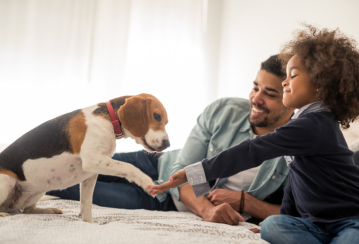News and Updates
Pet proof your home in 7 easy steps
As the colder months continue, many are looking for a furry companion to brighten up dark winter days. Before you bring home a new dog or cat, you’ll need to do a thorough inspection of your home and ensure any harmful objects and chemicals are out of reach from a curious pet. Follow these seven steps to create a safe environment for your new family member.
-
Safely stow all chemicals and foods that could harm your pet
Many common household goods can be harmful to pets, such as cleaners, detergents, mothballs, pesticides, antifreeze, pest poisons, medications, cosmetics, and more1. Make sure all these chemicals are either stored out of reach or behind child-proof latches.
There are also several common human foods that can be poisonous to pets, such as chocolate, avocados, grapes and raisins, macadamia nuts, onions, garlic, coffee, and alcohol — make sure these are securely stored as well1,2,3. For a full list of human foods and products that could harm your pet or make them sick, make sure to do your research prior to bringing your pet home.
-
Keep electrical cords out of sight
When chewed on, electrical cords can give a pet a nasty shock. Cover your electrical cords, chargers and power cables or tuck them away so they’re not tempting to your pet. You can also consider using deterrent sprays to prevent your pet from chewing on them.
-
Stash your trash
Lots of harmful things can end up in a trash can, so get garbage cans that lock or store them behind cupboard doors with child-proof locks.
-
Check your houseplants
Many common houseplants can be dangerous to cats and dogs when ingested. Examples include lilies, aloe vera, jade, dumb cane, elephant ear, devil’s ivy, ZZ plant, asparagus fern, and snowbread4. If you’re not sure what kind of plant you have, try searching the database on houseplant411.com to identify it. If you own a hazardous plant, put it out of reach of your pet or give it to a friend.
-
Remove choking hazards
Curious pets can sometimes choke on small objects such as twist ties, hair elastics, rubber bands, small toys, or puzzle pieces. Ingesting foreign objects can also cause bowel obstructions and result in a pricey veterinary bill, or possibly worse. When you’re not around to monitor your pet, make sure these objects remain tidied up and out of reach.
-
Give them their own space
Whether it’s a crate, a pen, or a room, prepare a space where your pet can be contained when you’re not at home. That way you can rest at ease knowing they’re safe and not getting into any unwanted trouble! If your pet knows that space is theirs, they’ll also appreciate having a quiet spot to retreat to where they feel safe.
-
Set some boundaries
There may still be places in your home where you don’t want your pet to explore, such as your garage or your kitchen when you’re cooking over a hot stove. If so, install a self-closing mechanism on the appropriate doors to ensure you won’t forget to close them or get pet gates to keep them out.
Sometimes, despite your best efforts, pets can still get into trouble. Although home insurance doesn’t cover damage to your home caused by a pet, it does cover damage your pet may cause to your neighbours’ property through your liability coverage. Ontario’s Dog Owner’s Liability Act mandates that owners can be held liable for dog attacks. If an incident happens, the courts will hear if the attack was provoked or if owners did all they could to prevent an attack. If the owner is held liable, liability coverage will kick in to help pay for expenses related to injuries.
If you’re getting a new cat or dog and you're a current OTIP policyholder, contact us at 1-833-615-9329 to review your existing home insurance policy’s liability coverage. If you’re not insured with OTIP and are shopping for home insurance, call us at 1-833-494-0085 to get a quote and receive a $20 gift card of your choice!





